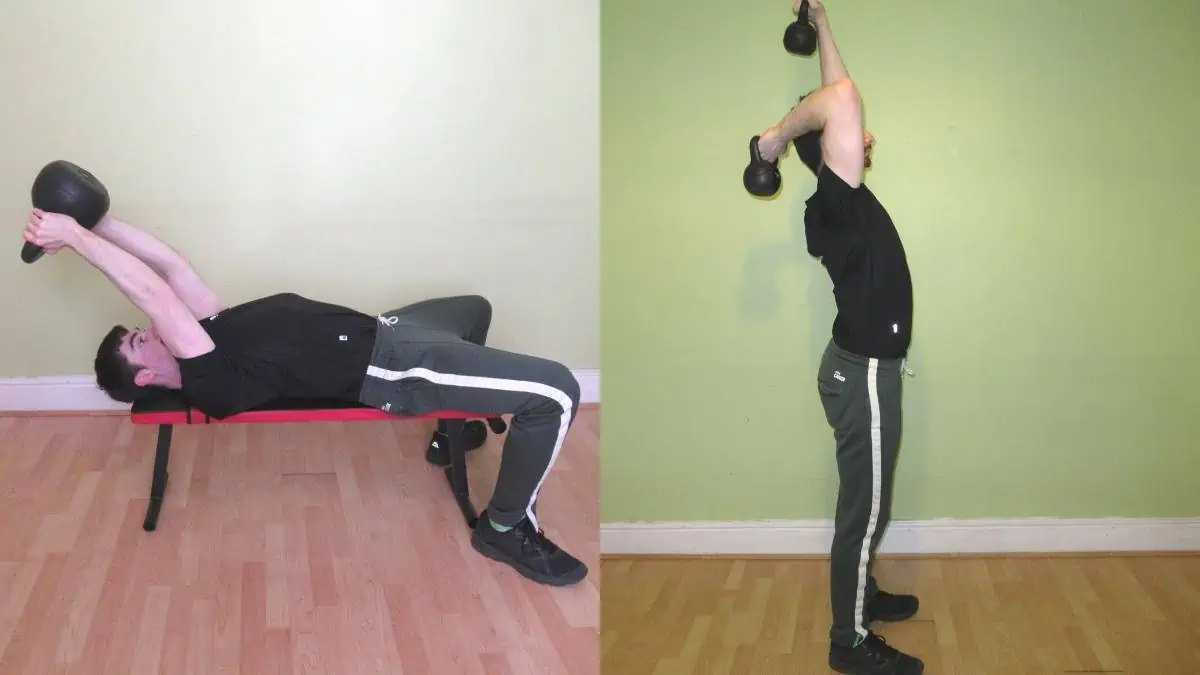If you want a list of the best kettlebell tricep exercises for muscle growth and strength development, then you’re in the right place. I tried over 20 different kettlebell triceps exercises and whittled down the contenders to a top 6 list.
After going over the pros and cons of each exercise, I’ll get into the full kettlebell tricep workout routines that you can follow. Each program caters to a different goal, so you’ll be sure to find a workout that suits your preferences.
Related Kettlebell Workouts:
The 6 best kettlebell tricep exercises
Here are the 6 best kettlebell exercises for triceps development. Learn the benefits and drawbacks of each movement and discover how to perform each exercise with the optimal form.
1. Kettlebell skull crusher

The kettlebell skull crusher, also called the kettlebell lying tricep extension, is an excellent mass-building movement because, when performed correctly, it absolutely hammers the long head of your triceps.
Why is the long head so important?
Because it’s the biggest head of the triceps brachii and the largest muscle in your upper arms. So if you want to build bigger, stronger arms, then you have to train the long head during your KB tricep workout.
But in order to train the long head optimally, you need to allow some backward shoulder movement during your skull crusher because, unlike the other two heads, the long head acts on the shoulder as well as the elbow.
In practice, this means lowering the kettlebells behind your head rather than directly to your forehead.
- Grab a pair of kettlebells and lie back on a weight bench.
- Press the kettlebells up so that they’re directly over your face.
- Bend your elbows and move your shoulders back to lower the weights behind your head.
- Descend until you feel a really deep stretch in your triceps.
- Reverse the movement by flexing your triceps forcefully. Keep going until your elbows reach complete extension.
- Repeat for 3-5 sets of 8-20 reps.
2. Kettlebell overhead extension
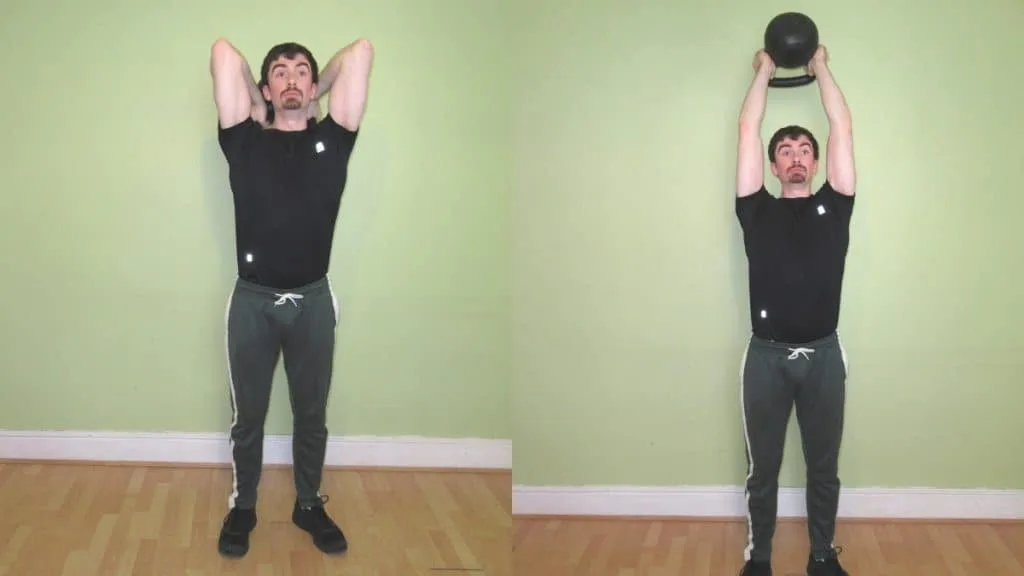
The overhead extension is one of the best KB tricep exercises that you can do for mass because, like the lying extension, it targets the all-important long head of the triceps.
You can do the KB overhead extension with one kettlebell if you want to maximally overload your triceps. Or, if you want to ensure that both of your triceps get equal amounts of work, you can lift a smaller kettlebell in each hand.
Using two smaller kettlebells may actually be easier because you can hold the handles as intended. Holding one big kettlebell, on the other hand, might overly tax your grip and hurt your wrists, which could detract from your triceps stimulation.
- Grab two kettlebells with an overhand grip and press them over your head.
- Lower the weights behind your neck by “breaking” at your elbows.
- Descend until you feel a strong stretch in the long head of your triceps.
- Flex your triceps to lift the weights back up. Keep going until your arms are once again locked out.
- Repeat for 3-5 sets of 8-20 reps.
3. Kettlebell close grip bench press

Performing your tricep exercises with kettlebells is great for your muscle symmetry because by lifting two separate weights, you can ensure that both of your triceps are getting equal amounts of stimulation.
However, the symmetry-sculpting benefits of kettlebell training don’t mean that kettlebells can’t build mass; if you perform the right movements with the proper form, tricep kettlebell exercises can build just as much mass as tricep barbell exercises.
The kettlebell close grip bench is an excellent exercise for gaining both size and strength because it enables you to overload the fast-twitch muscle fibers in your triceps by lighting much heavier weights than you would on tricep extensions.
Additionally, unlike the barbell version of the exercise, you’ll be holding the kettlebells with a neutral grip, which will take much of the pressure off your wrists and shoulders while also helping you to keep your elbows tucked in, which, in turn, will keep more of the tension on your triceps.
- Grab two heavy kettlebells (remember, heavy is relative) and lie on a bench.
- Press the weights up with a neutral grip so that your elbows are locked out.
- Retract your scapula by squeezing your shoulder blades together.
- Tighten your core, and then lower the kettlebells to your chest.
- Keep going until the weights almost touch your chest, then press them back up by extending your elbows and pushing your hands into the kettlebell handles.
- Perform 3-5 sets of 6-12 reps in total.
4. Kettlebell tricep kickback

I always include kickbacks in my kettlebell tricep workouts and dumbbell tricep workouts because kickbacks do one thing that other exercises do not; they train the long head of your triceps in its maximally contracted position.
If you think about it, a kickback is essentially the opposite of an overhead extension in terms of shoulder position; rather than putting your shoulders in flexion, you’re putting them in extension by moving them behind your torso.
Training your triceps from different angles like this will help to recruit a broader range of muscle fibers, which is important for maximizing muscle hypertrophy.
Additionally, you’ll be training your triceps where they’re naturally weak (muscles are naturally weakest in their shortened anatomical position). And, if you can get strong where you’re meant to be weak, then you’re going to have some pretty well-developed triceps, that’s for sure.
- Grab a pair of light kettlebells and bend over at your waist.
- Move your shoulders back and up so that they’re in line with your torso.
- While keeping your shoulders still, flex your triceps to “kick” the kettlebells back.
- Keep going until your elbows are fully locked out.
- Hold the peak contraction for a second and then lower the weights in a controlled manner.
- Repeat for 3-5 sets of 10-20 reps.
5. Kettlebell Tate press
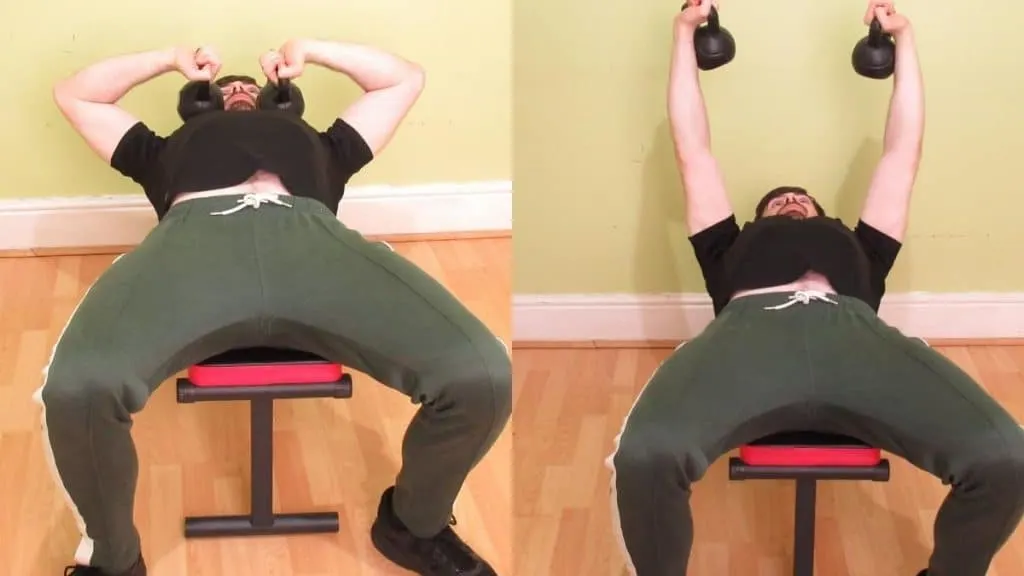
The Tate press is a great kettlebell tricep exercise that you can do with and without a bench because you’ll be lowering the weights to your chin rather than behind your head.
A Tate press is basically a tricep extension, but instead of pointing your elbows forward, you’re going to point them out to the sides and away from each other. Then, you’ll simply lower the weights to your chest area by bending your elbows.
You don’t need to use much weight for Tate presses to be effective, so it’s fine to do this KB tricep exercise later on in your workout after your heavy presses and skull crushers.
- Grab a pair of moderately light kettlebells and lie back on a weight bench.
- Press the kettlebells up and flare your elbows out to the sides.
- Bend your elbows to lower the weights to your chest area. Your elbows will naturally flare out even more as you do this.
- Descend in a controlled manner until you feel a strong stretch in your triceps.
- Reverse the motion by forcefully flexing your triceps until your elbows reach full extension.
- Perform 3-5 sets of 10-20 reps.
6. Kettlebell floor press

If you want to overload your triceps with plenty of mass-building resistance but don’t have a bench to do close grip bench presses, then the floor press is a great kettlebell tricep exercise to do instead.
Since you’re lying on the floor for this compound press, you can’t drive the weight up with your legs, which means that your chest, front delts, and, in particular, your triceps, have to handle the heavy weight by themselves.
To keep as much tension on your triceps as possible—and to keep your rotator cuffs and wrists out of trouble—make sure to hold the weights with a neutral grip. This hand positioning will enable you to tuck your elbows closer to your sides and thereby make the press more triceps-dominant.
- Place two kettlebells on the floor and then lie between them.
- Extend your legs all the way out in front of you so that your knees are locked out.
- Grab the kettlebells with a neutral grip.
- Press the weights up by flexing your triceps and just generally pushing into the handles.
- Once your elbows reach lockout, lower the weights slowly until the backs of your shoulders/arms touch the ground.
- Repeat for 3-5 sets of 6-12 reps.
Kettlebell tricep workout routines
These 3 kettlebell triceps workouts each cater to a slightly different goal, and the rep ranges and exercise selections reflect that.
Of course, since gaining strength and building muscle aren’t exactly polar opposite aims, there are still a lot of similarities between the KB tricep workouts.
Rest 2-4 minutes between sets of presses (especially if you’re training for strength) and 1-2 minutes between sets of extensions.
Kettlebell triceps workout 1: Get strong

If you want to boost your pressing power and increase your triceps strength, this is the workout routine for you.
The session starts with close grip bench presses to really hammer the fast-twitch tricep muscle fibers, of which there are plenty.
After that, it’s onto Tate presses to really isolate your triceps and add mass to all three heads.
Finally, it’s time for overhead extensions to work the long head, arguably the most crucial muscle in your upper arms.
1: Kettlebell close grip bench press — 3-5 sets of 4-7 reps
2: Kettlebell Tate press — 3-5 sets of 8-12 reps
3: Kettlebell overhead extension — 3-5 sets of 10-15 reps
Kettlebell tricep workout 2: Build muscle
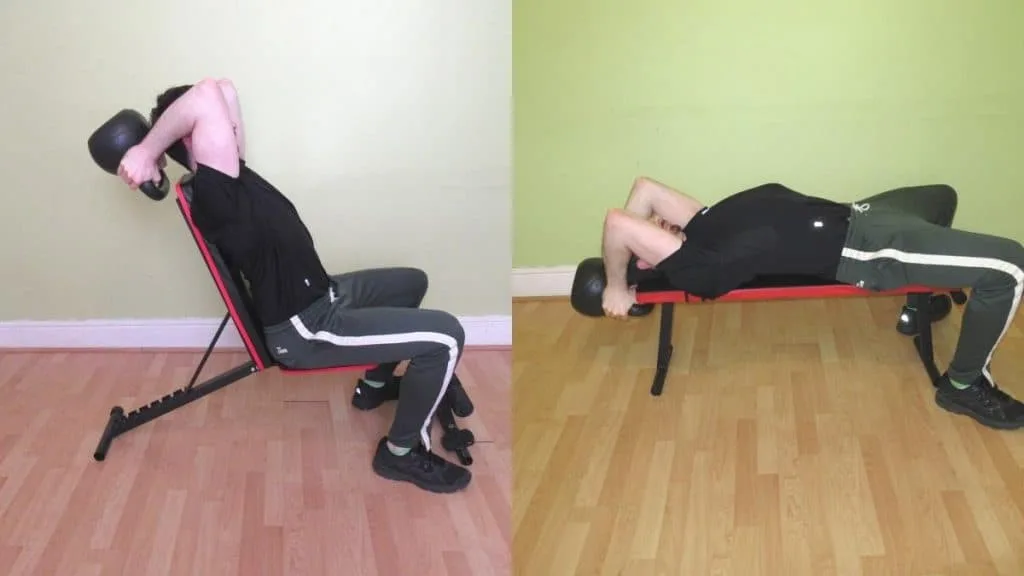
If you want to do everything you can training-wise to build your triceps with kettlebells, then this KB tricep workout is a great routine to follow.
As with the strength session, this muscle-building tricep kettlebell workout opens with close grip bench presses so that you can do your explosive lifting when you’re naturally at your freshest and strongest.
The first exercise for the long head of the triceps is the skull crusher. Just make sure to bring the weights behind your head to really place your triceps under that skin-splitting stretch that they need to grow.
After that, it’s time for a tricep-taxing superset; kickbacks and overhead extensions. These movements train your triceps from opposite angles and will make sure that no muscle fiber is left understimulated.
1: Kettlebell close grip bench press — 3-5 sets of 6-8 reps
2: Kettlebell skull crusher — 3-5 sets of 10-15 reps
3A: Kettlebell tricep kickback — 3 sets of 15-20 reps
3B: Kettlebell overhead extension — 3 sets of 15-20 reps
Kettlebell tricep workout 3: Limited equipment
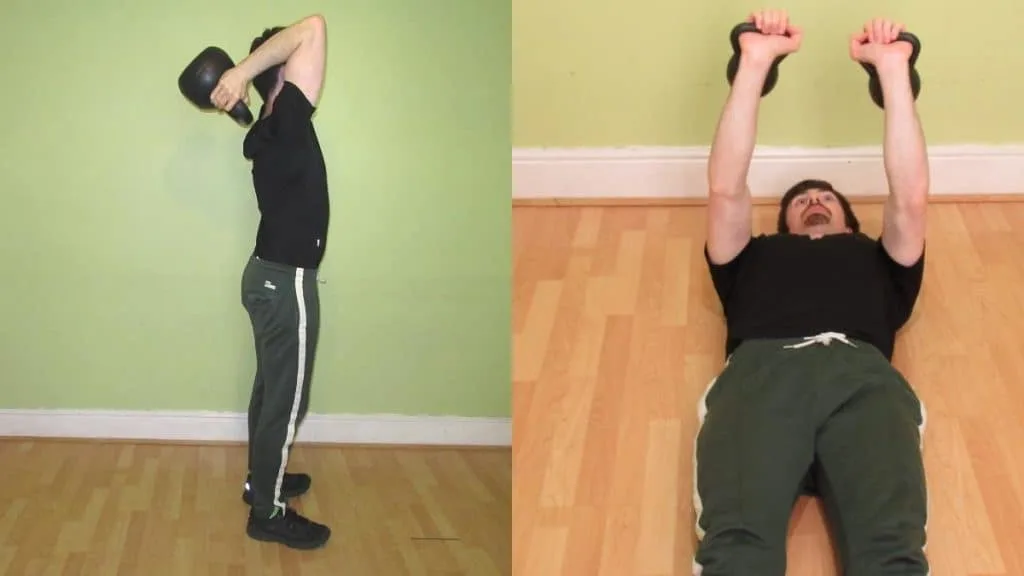
If you’re training at home or just don’t have access to a weight bench, then this kettlebell triceps workout is for you.
You can even do these three KB tricep exercises with one kettlebell if you want, which would actually be a great way to give your abs and obliques some extra stimulation.
Additionally, you can check out these resistance band tricep exercises if you don’t have access to any free weights but still want to pump up your triceps.
1: Kettlebell floor press — 3-5 sets of 6-10 reps
2: Kettlebell Tate press — 3-5 sets of 8-12 reps
3: Kettlebell overhead extension — 3-5 sets of 15-20 reps
Related: Cable tricep workout│Tricep bar workouts
Conclusion: Should you do tricep exercises with kettlebells or not?
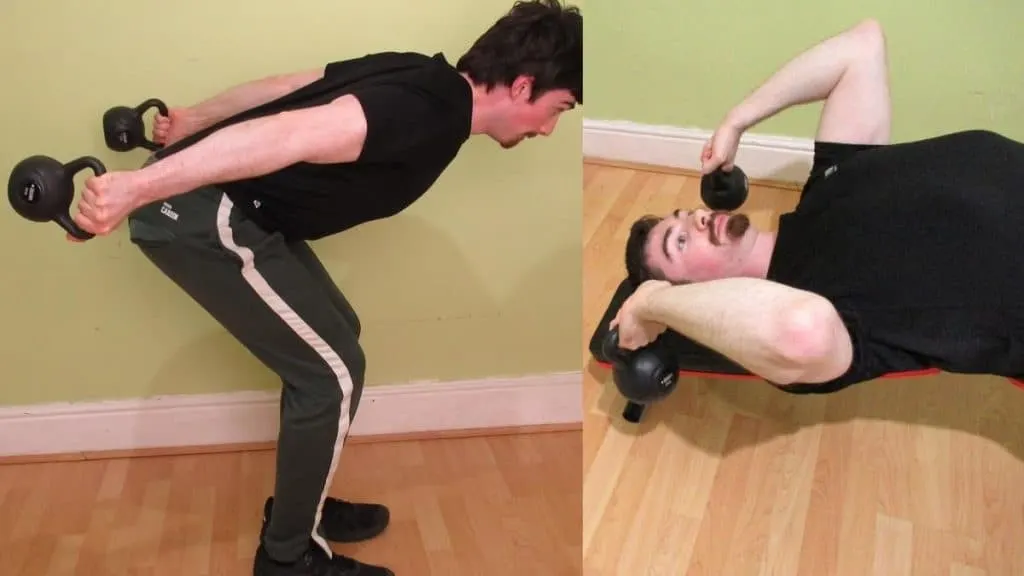
Performing your tricep exercises with kettlebells is a great way to vary up your workout routine and give your triceps a different stimulus.
Kettlebell tricep exercises are highly effective for building muscle because you can perform a wide variety of different movements such as close-grip presses, skull crushers, overhead extensions, and tricep kickbacks.
Additionally, since you’ll often be lifting one kettlebell per arm, kettlebell tricep workouts are naturally good for building proportional triceps, which can improve the appearance of your physique.
References
- Dale, P. (2021, January 11). The Best Long Head Triceps Exercises for Thicker, Stronger Arms. Fitness Volt. https://fitnessvolt.com/best-long-head-triceps-exercises/
- Fanslau, J. (2016, March 16). How to Do the Tate Press or Elbows-Out-Triceps Extension. Men’s Health. https://www.menshealth.com/fitness/a19517160/how-to-do-tate-press/

